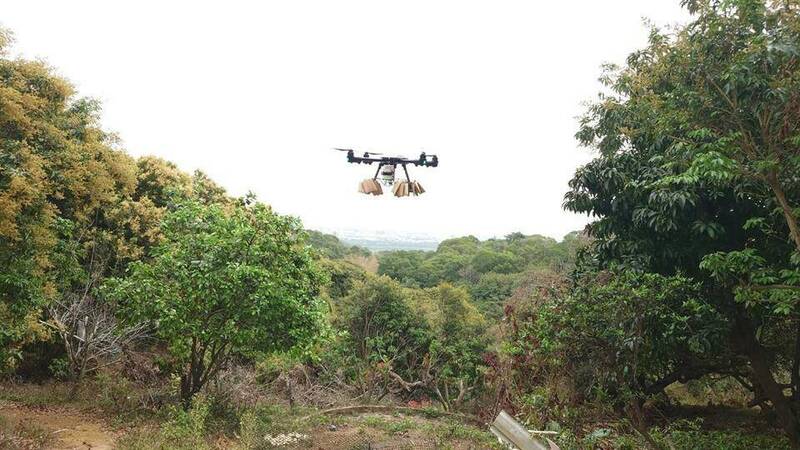Changhua prevents litchi stink bugs from harming lychee and longan. Recently, drones have been used to control the pests with flat-bellied bees.
(provided by the county government)
[Reporter Zhang Congqiu/Changhua Report] April enters the flowering period of lychee and longan fruit trees, which is also the spawning period of lychee stink bugs, a fruit tree pest. Changhua County has deployed in advance to prevent the possible outbreak of insect crisis in May. The dual-track attack uses drones to release the nemesis of lychee stink bugs, the flat-bellied wasps, in mountainous areas, and hangs the flat-bellied bees boxes through artificial land, allowing the flat-bellied wasps to parasitize the eggs of litchi stink bugs and attack the eggs to kill the pests.
The County Agriculture Department said that this year, the lychee trees are blooming better than in previous years, and the bees are collecting honey for pollination. In order to avoid harming the bees by applying pesticides, the Agriculture Department recommends that farmers stop using chemical agents for lychee stink bugs during the flowering period, and use physical control or biological control instead. For prevention and control, March and April are the spawning period of lychee stink bugs. Adults begin to appear in large numbers in May, and the damage period lasts until July and August. During the spawning period, the lychee stink bug is controlled by the flat-bellied bee, and the control effect is the best.
Please read on...
Before the Qingming holiday last week, the county government launched the first drone, which flew into the sky of Changhua City, Fenyuan Township, Yuanlin City, Shetou Township and other mountainous areas to release flat-bellied bees. Hang the flat-bellied bee box, and the female wasp will lay eggs in the eggs of litchi stink bugs. The parasitic eggs cannot hatch stink bug nymphs smoothly, and the flat-bellied wasps that emerge from the eggs after 20 days can be born In the field, continue to search for the eggs of litchi stink bugs to parasitize, so as to achieve the effect of attacking eggs with eggs.
The first wave of release of flat-bellied wasps was completed on March 29, followed by the second and third times at intervals of 10 to 14 days, for three consecutive times, 1.44 million flat-bellied wasps will be released during the laying period of lychee stink bugs Parasitize one after another and reproduce offspring, thereby forming a living group and effectively reducing the hatching of pest eggs.
The Department of Agriculture pointed out that in March and April, drones were launched to release flat-bellied wasps to solve areas that are difficult for manpower to reach and improve the control effect. Starting in May, adults of litchi stink bugs appeared, and then drones were started to spray saponin (potassium fatty acid) for prevention and control , Saponin can prevent stink bugs from building nests and laying eggs. Past experience has shown good results.
In Changhua's dual-track attack by land and air, personnel entered the orchard to hang boxes of flat-bellied wasps, allowing the flat-bellied wasps to parasitize the eggs of lychee stink bugs and attack the eggs to kill the pests.
(Provided by the Department of Agriculture)
Every March and April is the spawning period of litchi stink bug, a pest of longan and litchi trees.
(provided by the county government)
The litchi stink bug enters the spawning period in March and April every year, and hatches into adults in May, endangering the growth of litchi and longan.
(provided by the county government)
